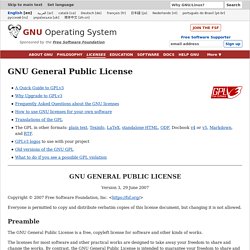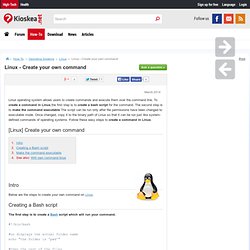

Login with root user without password after boot. GNU/Linux. Arch Linux. Licence publique générale GNU, v3.0 - Projet GNU - Free Software Foundation (FSF) Version 3, 29 June 2007 Copyright © 2007 Free Software Foundation, Inc.

< Everyone is permitted to copy and distribute verbatim copies of this license document, but changing it is not allowed. Preamble The GNU General Public License is a free, copyleft license for software and other kinds of works. The licenses for most software and other practical works are designed to take away your freedom to share and change the works. When we speak of free software, we are referring to freedom, not price. To protect your rights, we need to prevent others from denying you these rights or asking you to surrender the rights. For example, if you distribute copies of such a program, whether gratis or for a fee, you must pass on to the recipients the same freedoms that you received. Developers that use the GNU GPL protect your rights with two steps: (1) assert copyright on the software, and (2) offer you this License giving you legal permission to copy, distribute and/or modify it.
Linux - Create your own command. Linux operating system allows users to create commands and execute them over the command line.

To create a command in Linux,the first step is to create a bash script for the command. The second step is to make the command executable.The script can be run only after file permissions have been changed to executable mode. Once changed, copy it to the binary path of Linux so that it can be run just like system-defined commands of operating systems. Follow these easy steps to create a command in Linux. Intro Below are the steps to create your own command on Linux. Creating a Bash script The first step is to create a Bash script which will run your command. #! Save this file (CTRL + O with Nano) give it the name of your command (Example: FileInfos). Make the command executable Try to type the name of your bash script, you will notice that it will be executed (run).
See also In the same category. ArchWiki. The Arch Way. This page is intended to be a page to demystify common terms used among the Arch Linux community.

Feel free to add or modify any terms, but please use that particular section's edit option. If you decide to add one, please put it in alphabetical order. The Arch Build System (ABS) is useful to: Make new packages of software for which no packages are yet available Customize/modify existing packages to fit your needs (enabling or disabling options) Re-build your entire system using your compiler flags, "a la Gentoo" Getting kernel modules working with your custom kernel. Arch Linux. Linux: Boot to text mode instead of graphical interface. So you installed your Linux server with gnome or kde and now want to boot to text mode, mostly to save some resources that are being used by your X server… Debian: go to /etc/init.d and execute: update-rc.d -f gdm remove for kde: update-rc.d -f kdm remove to restore: update-rc.d -f gdm/kdm defaults The above command works for pretty much any script you want loaded during boot.

CentOS/REHL: Edit your GRUB nano /boot/grub/menu.lst and add runlevel you need to the boot line. Kernel /vmlinuz-2.6.9-78.0.1.EL ro root=LABEL=/ rhgb quiet 3 SuSE: Edit grub and add level 3 to your boot line: kernel /vmlinuz-2.6.27.21-0.1-pae root=/dev/sda5 resume=/dev/sda9 splash=silent crashkernel=128M-:64M@16M showopts vga=0x317 level 3 You can always run to graphical mode by using the command: startx Other distros: google it Be Sociable, Share! Booting linux into text mode and using startx to start the gui.
Installer linux a partir d'un serveur. Ubuntu. Communauté francophone d'utilisateurs d'Ubuntu.